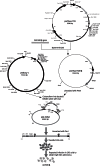Adenovirus-mediated RAR-β over-expression enhances ATRA-induced neuronal differentiation of rat mesenchymal stem cells
- PMID: 23671444
- PMCID: PMC3648816
- DOI: 10.5114/aoms.2012.31410
Adenovirus-mediated RAR-β over-expression enhances ATRA-induced neuronal differentiation of rat mesenchymal stem cells
Abstract
Introduction: The retinoic acid (RA) signaling pathway plays important roles in neural development. All-trans retinoic acid (ATRA) activates the RA signal by regulating RAR-β in mesenchymal stem cell (MSC)-derived neuron cells. Here, we try to investigate whether RAR-β over-expression can affect neuronal differentiation of MSCs.
Material and methods: The RAR-β gene was constructed into adenovirus Ad-RAR-β by using the AdEasy system. The MSCs were infected with Ad-RAR-β. Real time-polymerase chain reaction (RT-PCR), Western blot and immunofluorescence were performed to detect the expression and localization of RAR-β. The MSCs were treated with 1 µmol/l ATRA and modified neuronal induction medium (MNM). Soma size and axon length of induced neurons were measured. Neural specific markers were detected by RT-PCR, western blot and immunofluorescence to evaluate neuronal differentiation.
Results: The 1300 bp fragment of RAR-β gene was confirmed to be correctly cloned in the adenovirus vector. Cloudiness amplification of Ad-RAR-β was observed in HEK293 cells during package. After 48 h of Ad-RAR-β infection, about 70% of MSCs were RFP-positive. RAR-β expression was increased by about 1988-fold and located in the nucleus. RAR-β over-expression did not affect neuronal differentiation efficiency; however, soma size of induced neuron cells enlarged from 716.25 ±95.96 µm(2) to 1160.12 ±352.65 µm(2) and axon length from 64.17 ±11.88 µm to 83.98 ±13.69 µm. Neural markers other than nestin - NSE, MAP-2, Tau, and Tuj1 - were increased by 4- to 11-fold in RAR-β over-expressed neuron cells with ATRA/MNM induction compared with the Ad-null control group.
Conclusions: Our results have demonstrated that adenovirus-mediated RAR-β over-expression could facilitate neuron cell types of MSCs in vitro, indicating that the RAR-β-activated RA signal might be a vital factor in neuronal differentiation.
Keywords: all-trans retinoic acid; mesenchymal stem cells; neuronal differentiation; retinoic acid receptor β.
Figures




References
-
- Pimentel-Coelho PM, Mendez-Otero R. Cell therapy for neonatal hypoxic-ischemic encephalopathy. Stem Cells Dev. 2010;19:299–310. - PubMed
LinkOut - more resources
Full Text Sources
Other Literature Sources
